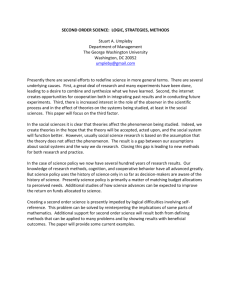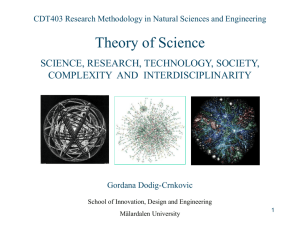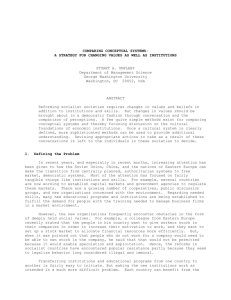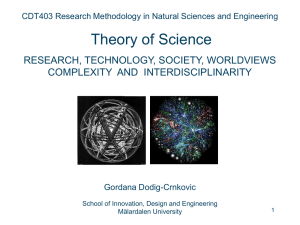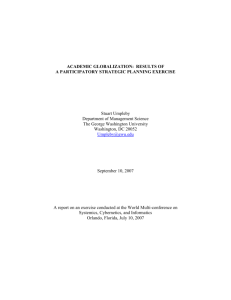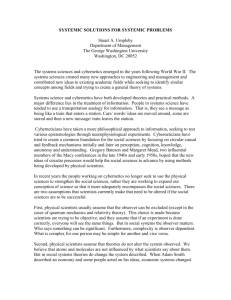How Can We Know that Ukraine is Ready for EU Membership
advertisement
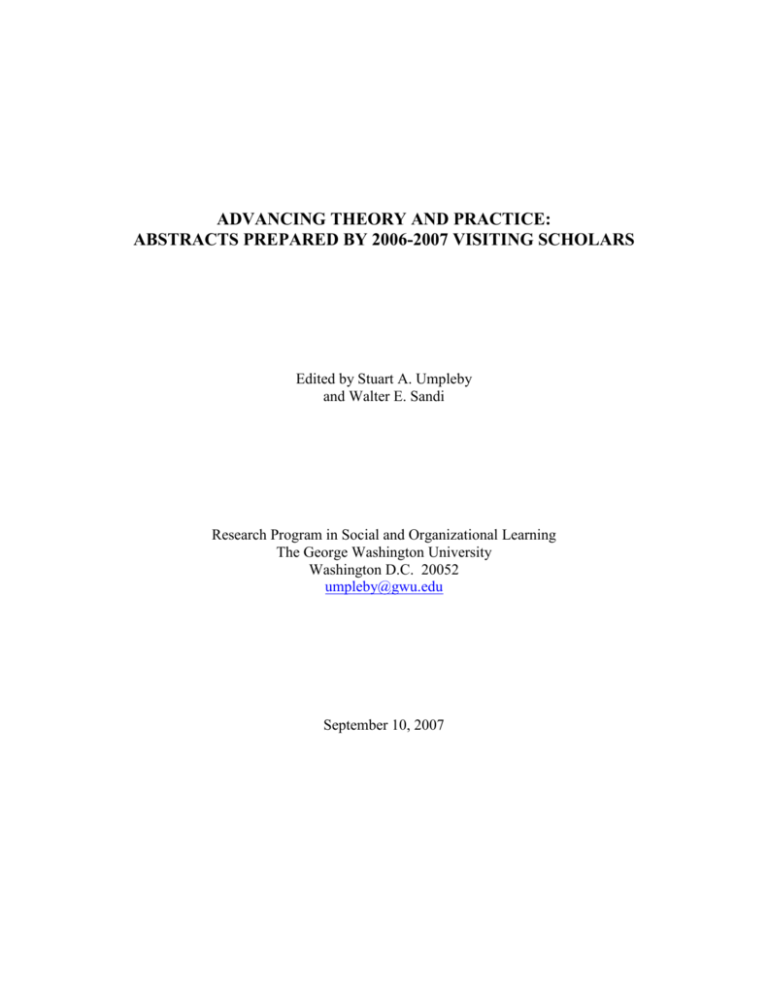
ADVANCING THEORY AND PRACTICE: ABSTRACTS PREPARED BY 2006-2007 VISITING SCHOLARS Edited by Stuart A. Umpleby and Walter E. Sandi Research Program in Social and Organizational Learning The George Washington University Washington D.C. 20052 umpleby@gwu.edu September 10, 2007 PREFACE The Research Program in Social and Organizational Learning at The George Washington University hosts visiting professors for periods of several months or an academic year. In the 2006-2007 academic year, the Research Program hosted 16 visiting scholars. Twelve were part of the Junior Faculty Development Program, which is funded by the U.S. Department of State’s Bureau of Educational and Cultural Affairs. These abstracts were prepared by professors and visiting scholars associated with the Research Program. Papers 1 to 3 were presented at the annual Faculty Research Forum of the Washington Consortium of Schools of Business held at Howard University on November 4, 2006. Paper 4 by Rozmat Ashurbekov and Frank Anbari was published in the Proceedings of the International Project Management Association (IPMA) 20th World Congress, held in Shanghai, China, October 15-17, 2006. Paper 5, which enhances and updates the previous paper, has been accepted for publication in the Journal of International Business and Economics (2007) and for presentation at the International Association of Business and Economics (IABE) Annual Conference to be held in Las Vegas, October 14–17, 2007. Paper 6 by Aida Sagintayeva was presented at a conference at The George Washington University’s Graduate School of Education and Human Development, February 24, 2007. Paper 7 by Stuart Umpleby was presented at the American Society for Cybernetics conference in Urbana, IL, March 29 – April 1, 2007. Paper 8 by Stuart Umpleby, Walter Sandi and ChunWu Lai describes a Participatory Strategic Planning exercise that the visiting scholars conducted in spring 2007. Paper 9 by Katerina Tosevska was presented at the International Trade and Finance Association conference in Miami, FL, May 16-20, 2007. Paper 13 by Linda Ihsani was presented at a meeting on international education in the GWU School of Education and Human Development, June 11, 2007. Paper 14 by Tanja Milosevska was presented at The George Washington University on April 26, 2007. Abstracts 15 and 16 were prepared for the 10th World Multi-Conference on Systemics, Cybernetics and Informatics, Orlando, FL, July 16-19, 2006. Paper 17 by Bidjan Nashat was prepared for Umpleby’s Organization and Management class in Fall 2006. Stuart A. Umpleby, Director Research Program in Social and Organizational Learning 2 CONTENTS 1. Oleksiy Gorovyy, Stuart Umpleby How Can We Know that Ukraine is Ready for EU Membership? 5 2. Oleksiy Gorovyy Creating a Quality-based Policy for Sustainable Development of Ukrainian Universities 6 3. Oleksiy Gorovyy, Irina Naoumova, Stuart Umpleby Identifying and Monitoring Organizational Priorities: A Comparative Study of an American and a Russian Academic Department 7 4. Rozmat Ashurbekov, Frank Anbari The Current State, Problems and Perspectives of Development of Modern Project Management Education in Uzbekistan 8 5. Frank Anbari, Rozmat Ashurbekov Project Management Research, Education, and Training in Transition Economies: The Case Of Uzbekistan 9 6. Aida Sagintayeva Improving Vocational Teacher Training in Kazakhstan 10 7. Stuart Umpleby Unifying Epistemologies by Combining World, Description and Observer 11 8. Stuart Umpleby, Walter Sandi , ChunWu Lai How Universities Can Improve Quality, Collaborate on Research and Increase Cooperation with Local Businesses 12 9. Katerina Tosevska Analysis of the Effects of the Stabilization and Association Agreement on the External Trade of the Republic of Macedonia 13 10. Ramazon Nazariev The Idea of God in the Thought of Nasir Khusraw and Rene Descartes 14 11. Ramazon Nazariev The Ethical and Moral Principles of Nasir Khusraw 16 12. Ramazon Nazariev My View of America: A Comparison of “the Melting Pot” and “the Kaleidoscope” 17 13. Linda Ihsani Brawls in Parliament: Real or Contrived? 19 3 14. Tanja Milosevska Organized Crime in South-Eastern Europe 20 15. Stuart Umpleby Fundamentals and History of Cybernetics: Development of the Theory of Complex Adaptive Systems 22 16. Stuart Umpleby Cybernetics as a Language for Interdisciplinary Communication 23 17. Bidjan Nashat How the Technology of Participation Could Improve the Integration of Refugees and Internally Displaced Persons in a Local Community_______24 4 How Can We Know that Ukraine is Ready for EU Membership? Oleksiy Gorovyy Department of Applied Mathematics National Transport University Kyiv, Ukraine Email: gorovyy@gmail.com and Stuart Umpleby Research Program in Social and Organizational Learning The George Washington University Washington, DC 20052 USA Email: umpleby@gwu.edu After more than fifteen years of independence and transition Ukraine still faces a number of challenges in pursuing its foreign policy. The Orange Revolution in 2004 captured the world’s attention and demonstrated the desire of the Ukrainian people to transform Ukraine into a state on the European model: democratic, prosperous, responsive to its people, concerned about civil rights and committed to the future of the European continent. Active participation of Ukraine in integration and globalization processes is a very realistic and natural way to achieve these goals. However, a year of political crisis has made the Euro-Atlantic policy of Ukraine unclear and uncertain in the minds of the political elites in Ukraine. Will Ukraine emphasize developing close ties with Europe, or will Ukraine focus on maintaining a close relationship with Russia? One of the most critical issues is achieving consensus on the timeline for the integration of Ukraine. Undoubtedly, “When?” is the most debated question during numerous international conferences, roundtables, briefings and interviews. The goal of the paper is to use key socio-economic indicators to compare Ukraine with the countries that joined the EU in 2004. The paper uses the method of “time-distance analysis” which was developed by Pavle Sicherl (1973, 1993) and was further developed in works by Nobel Prize winner Clive W. J. Granger (2003) on econometric forecasting, the creation of models using leading and lagging indicators. The results may be of interest to researchers, policy and decision-makers, political leaders and journalists as well as those who are interested in the process of European integration. 5 Creating a Quality-based Policy for Sustainable Development of Ukrainian Universities Oleksiy Gorovyy Department of Applied Mathematics National Transport University Kyiv, Ukraine Email: gorovyy@gmail.com During the last decade, technology, globalization and competition have significantly influenced the activity of Ukrainian universities. In May 2005 Ukraine became a full member of the Bologna Process. By joining the Process, Ukraine has confirmed a shared understanding of the principles, objectives and commitments of the Process as expressed in the Bologna Declaration. At the same time such modern social concepts as “the knowledge based society”, “the information and learning society” and “life-long education” are a real challenge for most of the contemporary Ukrainian higher education establishment. In order to respond to such external and many other internal pressures, Ukrainian universities have had to create new approaches to their policies and administration. As a result of comparing the procedures and infrastructure of US and Ukrainian universities, a course of action is suggested: effective moves towards implementing innovative quality and performance improvement strategies in educational institutions. Currently the philosophy of Total Quality Management is not widespread in the Ukrainian educational sector. This paper lists the principal tasks necessary to instill deeply the culture of quality improvement among administrators, scholars and students in Ukrainian universities so as to improve the performance of educational institutions. 6 Identifying and Monitoring Organizational Priorities: A Comparative Study of an American and a Russian Academic Department Oleksiy Gorovyy Department of Applied Mathematics National Transport University Kyiv, Ukraine Email: gorovyy@gmail.com Irina Naoumova Department of Management Kazan State University Kazan, Russia Email: inaoumov@utk.edu Stuart Umpleby Research Program in Social and Organizational Learning The George Washington University Washington, DC 20052 USA Email: umpleby@gwu.edu The Quality Improvement Priority Matrix (QIPM) is a method for achieving agreement among a group of people on the most important actions to be taken. It may be used for identifying the priorities of an organization. This paper reports on the use of the QIPM method in two academic departments: the Department of Management Science at The George Washington University in Washington DC, USA, and the Department of Management at Kazan State University in Kazan, Russia. Features of a department, such as salaries, teaching assistants, computer hardware, etc. (a total of 51 features), were evaluated on the scales of importance and performance in the years 2002 and 2006. The departments’ priorities are identified and the amount of consensus among the faculty members is measured. In addition, how the priorities of the departments changed between 2002 and 2006 is discussed. 7 The Current State, Problems and Perspectives of Development of Modern Project Management Education in Uzbekistan Rozmat Ashurbekov Tashkent State Aviation Institute Tashkent, Uzbekistan and Frank Anbari The George Washington University Washington, DC, USA The current state, problems and perspectives for advancement of project management (PM) education are considered by analyzing published literature and materials on the progress of project management education in developed, developing, and transition economies. As a specific case, the development of PM research, education, and practice in Uzbekistan is discussed, and the need for strengthening the PM profession is highlighted. The strategic importance and the role of theories and practices of PM in the development of a project-oriented society, its well-being, and acceleration of its integration into the world economy are indicated. Recommendations for rapid development in PM education are suggested. 8 Project Management Research, Education, and Training in Transition Economies: The Case Of Uzbekistan Frank Anbari The George Washington University Washington, DC, USA and Rozmat Ashurbekov The Tashkent State Institute of Culture Tashkent, Uzbekistan Over one-fifth of the world’s gross domestic product consists of gross capital formation, which is generally project and program based, highlighting the importance of project management. In transition economies, this proportion tends to be higher than in mature economies, making the need for effective project management particularly critical in transition economies. Research, education, training, and practice of project management play a strategic role in the development of project-oriented societies as well as transition economies, their well being, and acceleration of their integration into the world economy. This paper considers the current state, challenges, and perspectives for advancement of project management research and education in transition economies by analyzing published literature on the progress of project management education in developed and transition economies. As a specific case, issues of development of project management research, education, and practice in Uzbekistan are discussed, and the need for strengthening the project management profession is highlighted. Recommendations for rapid development in project management education are suggested. 9 Improving Vocational Teacher Training in Kazakhstan Aida Sagintayeva Office of International Educational Programs Gumilyov Eurasian National University Astana, Kazakhstan Vocational teacher training in the Republic of Kazakhstan has undergone extensive reform since 2003. Kazakhstani vocational teacher training has a rich history. Educational colleges and institutes and schools of education within universities currently provide vocational teacher training. Teachers are trained for three levels of educational institutions: schools, colleges and universities. Different types of educational institutions use different theoretical and methodological approaches and award different levels of academic degrees. In recent years Kazakhstani government policy has designated the educational field as a national priority. Based upon state regulations and initiatives the State Program for Educational Development for 2005-2010 was established. The major goals of the State Program are improving teaching performance, achieving sustainability of academic programs and academic curricula, and maintaining a high quality of education. The article also describes how Kazakhstani educational institutions are being integrated into the Bologna Process. 10 Unifying Epistemologies by Combining World, Description and Observer Stuart Umpleby The George Washington University Washington, DC umpleby@gwu.edu The epistemologies of realism, constructivism, and pragmatism can be viewed as emphasizing different combinations of world, description and observer. Realism emphasizes world and description. Constructivism emphasizes observer and description. Pragmatism emphasizes observer and world. These three epistemologies are similar to three stages in the development of cybernetics – engineering cybernetics, biological cybernetics, and social cybernetics. Viewing the three epistemologies as emphasizing different facets of a triangle clarifies the relationships among the epistemologies and creates an opportunity for unifying them. Advocates of each point of view tend to direct a conversation toward the issues of greatest interest in that epistemology. 11 How Universities Can Improve Quality, Collaborate on Research and Increase Cooperation with Local Businesses Stuart Umpleby Washington, DC, USA Walter Sandi La Paz, Bolivia Chunwu Lai GuanXi, China In the spring semester of 2007 sixteen visiting scholars from the former Soviet Union, the former Yugoslavia, Albania and China conducted a Participatory Strategic Planning (PSP) exercise at The George Washington University. Through the PSP exercise we demonstrated the group facilitation methods called the Technology of Participation and developed plans to implement quality improvement programs and greater self-reliance in the universities of the visiting scholars when they return home at the end of the academic year. The results of the planning activity suggest several actions to work on in the coming year: improve international contacts, find new sources of financing, promote faculty selfdevelopment, increase faculty oversight of the university administration, and improve university infrastructure. The intent is that the participants not only will implement the plans devised but also will continue using the PSP method with their colleagues and local organizations when they return to their home countries. 12 Analysis of the Effects of the Stabilization and Association Agreement on the External Trade of the Republic of Macedonia Katerina Tosevska Faculty of Economics University “Ss. Cyril and Methodius” Skopje, Republic of Macedonia katerina@eccf.ukim.edu.mk or tosevska@gmail.com The European Union has launched a Process for Stabilization and Association for establishing external relations with the countries of the Western Balkans: Macedonia, Croatia, Albania, Serbia, Montenegro, and Bosnia and Herzegovina. The Republic of Macedonia signed the Stabilization and Association Agreement (SAA) with the European Union in 2001. Besides the legal framework, the Stabilization and Association Agreement established an asymmetrical liberalization of trade between the EU and the Republic of Macedonia in favor of the Republic of Macedonia. The asymmetrical liberalization of trade meant that the Republic of Macedonia had a longer transitional period for liberalizing the so-called sensitive sectors like textiles, agricultural products and the steel industry. The purpose of this paper is, through analysis of the external trade of the Republic of Macedonia, to show some effects that resulted from the asymmetrical preferences in trade. Although the analysis shows that the Republic of Macedonia has experienced considerable growth in external trade, more notable is the diversion of trade flows toward the European Union, mostly as a result of the asymmetrical treatment. The analysis indicates that so far the asymmetrical liberalization of trade toward the EU has not helped in strengthening the competitiveness of Macedonian export products or in strengthening the Macedonian position in international markets. 13 The Idea of God in the Thought of Nasir Khusraw and Rene Descartes Ramazon Nazariev Tajik State Pedagogical University Dushanbe, Tajikistan The idea of God held an important position in Western and Eastern philosophy almost until the 19th century, and disputes on the subject have not stopped. The idea of God did not become 'scientific' and has remained at a level of guesses, assumptions and theory or, as a last resort, logical constructions of syllogisms. It is important to examine how this idea has developed in the thinking of philosophers who had no communication with each other. Nasir Khusraw was a Tajik philosopher who lived in the 11th century AD and was a representative of Ismailism, one of the rationalistic schools of Islam. Rene Descartes was the founder of a new rationalistic philosophy in the West in the 17th century AD. Their ideas about God are compared. The ideas of Nasir Khusraw and Rene Descartes concerning God are summarized as a structured scheme which is displayed as follows: Nasir Khusraw God is a necessary being Rene Descartes Method of doubt God is not a direct reason of our essence Cogito, ergo sum Emanative theory and the correlation of Criteria of truth soul and body Anthropological and psychological proofs Ontological, anthropological and of the existence of God psychological proofs of the existence of God Skepticism God is a necessary being Whereas Khusraw begins with the belief that God is a necessary being and concludes with skepticism, Descartes begins with doubt and concludes that God is a necessary being. Both of the philosophers when speaking about the possibility of achieving knowledge of the world emphasize affirmation of the perfection of the God-creator, but they do this sometimes in the same way and sometimes differently. There is a similarity of thought in their approaches – Nasir Khusraw’s skepticism and Descartes’ doubt. They select separate attributes and concepts related to God. For example, in the thought of Nasir Khusraw the concept of "light" is a certain source of true knowledge or His potentiality. The difference, as a whole, consists in the following: for Descartes, God is the Creator of man. Descartes’ reasoning starts with conceiving "I" as the critical responsible intellect. For Nasir Khusraw, God is the Creator of the world and only later 14 man. Therefore, his analysis of God’s essence has a deductive character. If Descartes’ philosophy is based on “I think”, Nasir Khusraw’s reasoning is based on how God "thinks" about the world. Descartes’ world, as was said early in his theory of true knowledge, contains an ethical shade. But for Nasir Khusraw the aesthetic character is reflected in uncountable emanations of light (potentiality) of God in the soul of man. The soul of man aspires to perfection, to infinity. Each soul of man, as a unique individual source of life, is involved in drawing together the harmony of the entire world. 15 The Ethical and Moral Principles of Nasir Khusraw Ramazon Nazariev Tajik State Pedagogical University Dushanbe, Tajikistan The ethical and moral principles of Nasir Khusraw, an eleventh century Tajik philosopher, are a product of an epoch of the Muslim Medieval Period. His thinking developed in the context of the socio-historical and cultural events of his time and his region. The ethics and morals in Nasir Khusraw’s writings in many respects can be reduced to the familiar idea of the perfection of man – the theory “insani kamil” (“the perfect man”) which presumably is borrowed from Sufism. But this is of only esoteric value, since Khusraw excludes a mysticism included in Sufism theory. For Nasir Khusraw the problems of morals are not paramount and are solved in terms of “the perfection of souls” of people. Virtues which might be possessed by a man as a result of his own independent endeavors are considered to be knowledge. Those virtuous characteristics are displayed as knowledge. Therefore, the moral life and virtuous behavior correspond to knowledge and genuine ideas within the mind of a man, but immoral behavior corresponds to ignorance. Compared to other ideological schools of Islam and representatives of their philosophical doctrines, there are some conflicts in understanding and interpreting the ethical problems of Nasir Khusraw. These conflicts primarily arise because there is more accumulation of forward development, an increment of knowledge, personal philosophical creativity, an orientation to rational methodology and the achievements of the physical sciences of that time in the thought of Khusraw. This orientation is less concerned with mythological thinking, figurativeness and beauty of language. Nasir Khusraw used ethics and morals as a way of theoretically analyzing of the practical problems rising in an ordinary life: the nature of good and evil, ways to achieve spiritual understanding of life, what is required and what is forbidden, the purpose of man and his sense of his life, ideals and duties, principles and rights of behavior, and other similar matters. These rights and principles are considered by Khusraw as both part of the consciousness of all members of a society, and as part of the conscience of a single man. This judgment was proved by Nasir Khusraw not through a traditional explanation of ethics and morals as was used in the works of many thinkers of the Muslim East, but through a rational and logical understanding of ethics and its principles. In other words, by means of an allegorical interpretation of philosophical and theological problems, Khusraw made a resolute and serious step from mythology and religion toward philosophical rationalism and logical judgments. 16 My View of America: A Comparison of “the Melting Pot” and “the Kaleidoscope” Ramazon Nazariev Tajik State Pedagogical University Dushanbe, Tajikistan American culture in its metaphorical description is similar to a “melting pot” in which many conditions contribute to the “melting”. The Soviet Union also had people of different nationalities and cultures. The difference was that the republics of the former Soviet Union were created by a principle of national identity. In America, except for unusual cases, this principle did not exist below the level of the country as a whole. The Soviet Union could be said to use another metaphor. I have named it “a kaleidoscope” where beautiful ice floes of different cultures gave a certain beauty. But they were like ice floes. They could not melt. The problem of man and his interests. A man alone is not able to pursue his interests. Therefore, he unites with others in groups or societies, having lost a part of his freedom and rights. As in “the melting pot” and in “a kaleidoscope” people equally aspire to being grouped, preferably with relatives, to be together with them, rather than with others. This preference appears especially when a person meets vital difficulties, such as financial problems when he can lean, ultimately, only on his “own”. Formation of “own” in the Soviet Union with its national republics is clear. And how is it in the USA? There are streets of Russians and Chinese in New York and other great cities as well as the States where some have majorities of Latin, European, African and people from others cultures. How is a balance of cultures of different people preserved in these places? America answers this question with a uniform law – the Constitution which has changed very little in more than 200 years, but obeying the law remains obligatory for all. Each citizen of the USA recognizes, respects and carries out the laws. The problem of “nation” and “race”. These conceptions, as is known, are used by politicians to break human associations, unions and groups in order to achieve easier management of them. In “the kaleidoscope” representatives of other regions, especially from the Caucasus and Central Asia have been the subject of humiliating expressions offending their people. This was especially terrible in terms of the young men from these regions who served in the Soviet military. What happens in “the melting pot”? There was a conversation with the owner of a car, a black woman, in the newspaper. In the conversation she with bitterness reminded people of slavery times and of discrimination against black people, emphasizing, that this discrimination still has not been eliminated. Then she nodded her head to the black people cleaning roads and the homeless people. But she added: “They are guilty, because they do not wish to struggle for life, do not wish to study, work…”. As for the military of the USA, black men serve more than others, but among the politicians of the country people of this race are at the highest levels of employment, for example the mayor of Alexandria, VA. 17 The instinct of self-preservation, fear for safety, and fear of government were created in the Soviet Union, which gradually transformed the person into an obedient subordinate, into a slave. A slavish mentality was created in the consciousness of people. One can recall the words of Machiavelli who said that a good governor is one who can hold people in fear and deceit and then can prove to them the correctness of this deceit and lie. All policies of the republic leaders of the former USSR were constructed on this principle. So, a person lost freedom completely. It is freedom for the sake of which he always and everywhere struggled and struggles. That freedom is provided in America. You go on streets of Washington or New York and nobody asks you who your father is (if you will not break the law!), what is you skin color, religion, race, nationality … The problem of American individualism and Soviet collectivism. Soviet collectivism meant that power was united in all facilities – collective farms, state farms, a uniform party of “all”, a uniform power of “all”, “common” factories and companies… But they did not become common or collective properties. Theft, corruption, and tampering with facts and figures, unreasonable plans of manufacture and so forth did not reflect the interests of all. Inside of this collectivism gradually grew a tendency of people to protect private, individual interests. American individualism treats all things as private, beginning from spiritual beliefs up to material interests and the rights of man. Part of these rights protects a person from the power of the state. That is one part of the question. Another part consists in the degree of display of individualism within man’s nature and his relationship with others. In America one can see how alone many men and women live. It is common. Everyone lives for himself without nervous excesses. A neighbor might not have a conversation with his neighbor, except for a greeting in the morning or in the evening, or he does not know who his neighbor is. The problem of spiritual life. It would be desirable to speak about libraries and museums. Not including museums in great cities, for example a fine museum such as the Hermitage in St. Petersburg, in other cities in the USSR museums were poorly maintained. Each exhibition offered the same: the first displays were allocated to the "beauty" of portraits of Communist Party leaders, beginning from Lenin up to Gorbachev, “fine landscapes” of peasants in a field, a worker behind a machine, an “image” of a pioneer or komsomol member walking with his father – the communist and so forth. I shall not speak about the great museums of Washington or New York. I need to visit them more and to enjoy what I shall see there. I am assured of it, because I saw smaller, but fine museums in smaller cities in Kansas. It is hard to describe the beauty of the products at the entrance to these museums, not speaking about what is inside them. Do you wish to visit the Library of Congress? Only register in advance and enjoy! Could I get into the library of the Kremlin in this way? 18 Brawls in Parliament: Real or Contrived? Linda Ihsani Adviser to the Speaker of the Parliament Tirana, Albania Brawls have occurred in a number of national legislative bodies around the world throughout history. In the last decade brawls have become common and in the parliaments of developing countries and new democracies. Why do Members of Parliament (MPs) resort to such extreme acts? Is a brawl the result of an emotional outburst, or is it an intentional act? Based on facts gathered in the media, this paper explores this behavior and the factors leading to it. The first part of the paper presents a short introduction and background on where and how this phenomenon takes place and why it is often labeled as rage by the media. The second part analyzes factors that provoke brawls. It focuses on how political issues and pressure tactics act as catalysts for an outburst of strong emotions combined with violent acts in parliaments. The third part describes how brawls evolve and end and focuses on reasons for brawls unfolding in legislative debates. It lists the consequences deriving from a brawl in parliament. Finally, the last part is related to brawls as an indicator of the maturity of politicians and the politics of a country and how they affect the political climate of a country. 19 Organized Crime in South-Eastern Europe Tanja Milosevska Professor of Defense and Peace Skopje, Macedonia tmilosevska@gmail.com In recent years, subjects regarding security are drawing the attention of a great number of citizens in democratic countries. However, the increasing presence of organized and transnational crime must not go unnoticed, although it does not arouse much media interest or public alarm. There is no doubt that it is one of the greatest challenges that democratic societies must confront in the future. Today, the phenomenon of organized crime in South-Eastern Europe is increasingly receiving the attention of national governments, international organizations and public opinion as it “represents a very serious and growing threat not only for the countries in the region, but also for the rest of Europe”, since “the Balkans have become the gateway to Europe for organized criminals”. While the structure of criminal groups is heterogeneous, a common feature of organized crime in South-Eastern Europe is its transnational nature. Often, the fact that crime is organized only becomes apparent when considered from an international perspective. Criminal groups in South-Eastern Europe are involved in: Extortion and racketeering Large-scale smuggling in consumer goods, in particular cigarettes (e.g., during the Kosovo crisis) Arms trafficking Organizing illegal immigration Trafficking of human beings, particularly for sexual exploitation (The main source countries of victims who are trafficked to the EU for sexual exploitation are: Moldova, Ukraine, Bulgaria, Romania, Russian Federation, Albania). Trafficking in drugs Trafficking in stolen vehicles (According to information provided by some Member States, vehicles stolen mainly in Germany, Belgium, France and Italy are transported principally towards the Russian Federation, Czech Republic, Poland, the Baltic States and towards South-Eastern Europe: Hungary, Slovenia, Croatia, Bosnia & Herzegovina, Albania, Serbia, Montenegro, Bulgaria and Romania). Intellectual property crime Environmental crime Forgery of documents and money 20 Economic crime, fraud and tax crime Money laundering South-Eastern Europe has become a bridge between the Middle Eastern and Central Asian drug producers and the lucrative Western European drug market. Via the Balkan route, heroin travels though Turkey, Macedonia, Kosovo and Albania to Western European markets. The estimated value of goods shipped might amount to 400 billion USD a year. Albanian drug dealers, for example, ship heroin from Asia, frequently from Afghanistan. From there, the heroin passes though Iran to Turkey, where it is refined. From there, the heroin is taken by Balkan/Albanian drugs dealers. According to the US State Department, four to six tons of heroin move through Turkey every month. The Albanian “Medellin connection” is particularly strong in Italy, where it operates with local mafia. Also Scandinavian countries claim that Albanians control 80% of the heroin market there. Switzerland says 90% of its drug market is connected to Albanians, and German law enforcement agencies claim that Albanians form the largest group involved in heroin trafficking. Holding all these factors in mind, any successful strategy to combat organized crime depends on a determined and joint effort of the governments concerned and the international community. In this context, several elements are essential, namely: – The independence of the judiciary – Adequate legislation on wealth control – Restraining parliamentary immunity – Transparency of government acts – Cooperation among the different national agencies dealing with combating organized crime (Intelligence Services, Police, and Border Police, etc.) International and regional cooperation also plays a very important role in drawing up a strategy for combating organized crime. No country can deal alone with organized crime. Only by international cooperation can we hope to decrease such activities. As examples of profitable cooperation in the region one could mention initiatives, such as The Southeast European Cooperative Initiative (SECI). The purpose of the SECI Regional Center for Combating Trans-Border Criminality is the fight against trans-border crime through “facilitating investigations, sharing experiences, and establishing joint operations using Task Forces for different investigations, and permanently evaluating and analyzing the crime situation in the region”. Combating organized crime requires pro-active thinking, which involves cooperation between the public and private sectors. It is also necessary to develop cooperation between executive institutions and legislative ones. 21 Fundamentals and History of Cybernetics: Development of the Theory of Complex Adaptive Systems Stuart A. Umpleby The George Washington University Washington, DC www.gwu.edu/~umpleby The field of cybernetics originated in a series of meetings in New York City between 1946 and 1953 sponsored by the Josiah Macy, Jr. Foundation. These conferences were attended by Norbert Wiener, John von Neumann, Ross Ashby, Gregory Bateson, Margaret Mead, Alex Bavelas, Kurt Lewin, J.C.R. Lickleider and others and chaired by Warren McCulloch. Since then the field of cybernetics has made notable contributions to the fields of computer science, robotics, management, family therapy, neurophysiology, philosophy of science, sociology, etc. From time to time ideas developed at the Macy meetings have been reinvented using names such as bionics, self-organization, complexity, or memetics, though frequently in less advanced form. This tutorial reviews the history of these ideas with emphasis on how concepts have evolved and how different groups have pursued different research agendas. Numerous examples of the key ideas will be given from a wide variety of fields. 22 Cybernetics as a Language for Interdisciplinary Communication Stuart A. Umpleby The George Washington University Washington, DC 20052 Umpleby@gwu.edu The field of cybernetics provides a general theory of communication and control. It offers a theory of information processing and decision-making whether these phenomena occur in machines, human beings, groups, organizations, nations, or supra-national organizations. Cyberneticians have developed theories of learning, adaptation, selforganization, regulation, cognition, and the management of complexity. Consequently cybernetics provides an interdisciplinary language for sharing the insights of many fields that have an interest in purposeful activity, goal formulation, and the evolution of complexity. This paper describes three theories from cybernetics – theories of the regulation of systems, self-organizing systems, and reflexive processes – and will give examples of each from several disciplines. 23 How the Technology of Participation Could Improve the Integration of Refugees and Internally Displaced Persons in a Local Community Bidjan Nashat Hertie School of Governance Berlin, 10178 Germany www.hertie-school.org b.nashat@mpp.hertie-school.org This paper suggests that the Institute of Cultural Affairs’ Technology of Participation method can serve as a useful tool for integrating refugees and internally displaced persons through income generation projects conducted by international humanitarian aid and development sector organizations. First, the paper briefly describes the method and its history. Then it describes a humanitarian NGO in Serbia, gives an overview of its activities and singles out areas where the Technology of Participation’s Participatory Strategic Planning method could lead to improvement of the organization’s work and increased impact on Serbian society. 24
